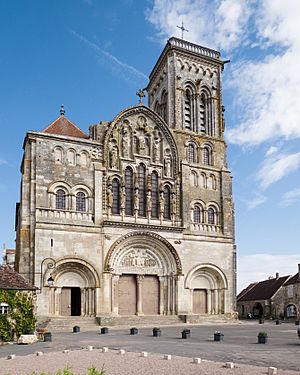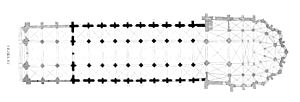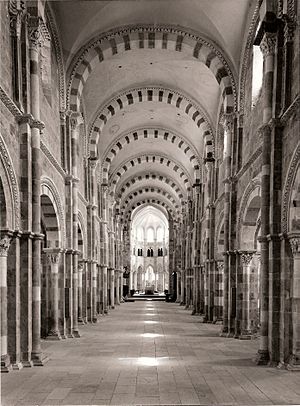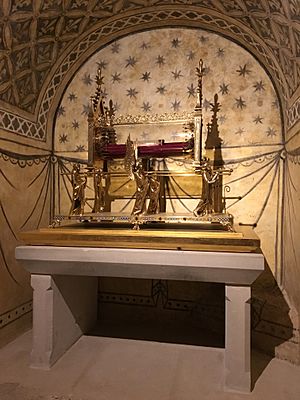Vézelay Abbey facts for kids
| UNESCO World Heritage Site | |
|---|---|

The abbey church in Vézelay
|
|
| Location | Burgundy, France |
| Criteria | Cultural: i, vi |
| Inscription | 1979 (3rd Session) |
| Area | 183 ha |
| Buffer zone | 18,373 ha |
Vézelay Abbey (French: Abbaye Sainte-Marie-Madeleine de Vézelay) is a Benedictine and Cluniac monastery in Vézelay in the east-central French department of Yonne. It was constructed between 1120 and 1150. The Benedictine abbey church, now the Basilica of Sainte-Marie-Madeleine (Saint Mary Magdalene), with its complex program of imagery in sculpted capitals and portals, is one of the great masterpieces of Burgundian Romanesque art and architecture. Sacked by the Huguenots in 1569, the building suffered neglect in the 17th and the 18th centuries and some further damage during the period of the French Revolution.
The church and hill at Vézelay were added to the UNESCO list of World Heritage Sites in 1979 because of their importance in medieval Christianity and outstanding architecture.
Relics of Mary Magdalene can be seen inside the Basilica.
History
The Benedictine abbey of Vézelay was founded, as many abbeys were, on land that had been a late Roman villa, of Vercellus (Vercelle becoming Vézelay). The villa had passed into the hands of the Carolingians and devolved to a Carolingian count, Girart, of Roussillon. The two convents he founded there were looted and dispersed by Moorish raiding parties in the 8th century, and a hilltop convent was burnt by Norman raiders. In the 9th century, the abbey was refounded under the guidance of Badilo, who became an affiliate of the reformed Benedictine order of Cluny. Vézelay also stood at the beginning of one of the four major routes through France for pilgrims going to Santiago de Compostela in Galicia, in the north-western corner of Spain.
About 1050 the monks of Vézelay began to claim to hold the relics of Mary Magdalene, brought, they said, from the Holy Land either by their 9th-century founder-saint, Badilo, or by envoys despatched by him. A little later a monk of Vézelay declared that he had detected in a crypt at St-Maximin in Provence, carved on an empty sarcophagus, a representation of the Unction at Bethany, when Jesus' head was anointed by Mary of Bethany, who was assumed in the Middle Ages to be Mary Magdalene. The monks of Vézelay pronounced this to be Mary Magdalene's tomb, from which her relics had been translated to their abbey. Freed captives then brought their chains as votive objects to the abbey, and it was the newly elected Abbot Geoffroy in 1037 who had the ironwork melted down and reforged as wrought iron railings surrounding the Magdalene's altar. Thus the erection of one of the finest examples of Romanesque architecture which followed was made possible by pilgrims to the declared relics and these tactile examples demonstrating the efficacy of prayers. Mary Magdalene is the prototype of the penitent, and Vézelay has remained an important place of pilgrimage for the Catholic faithful, though the actual claimed relics were torched by Huguenots in the 16th century.
To accommodate the influx of pilgrims a new abbey church was begun, dedicated on April 21, 1104, but the expense of building so increased the tax burden on the abbey's lands that the peasants rose up and killed the abbot. The crush of pilgrims was such that an extended narthex (an enclosed porch) was built, inaugurated by Pope Innocent II in 1132, to help accommodate the pilgrim throng.
Saint Bernard of Clairvaux preached at Vézelay in favor of a second crusade at Easter 1146, in front of King Louis VII. Richard I of England and Philip II of France met there and spent three months at the Abbey in 1190 before leaving for the Third Crusade. Thomas Becket, in exile, chose Vézelay for his Whitsunday sermon in 1166, announcing the excommunication of the main supporters of his English King, Henry II, and threatening the King with excommunication too. The nave, which had been burnt once, with great loss of life, burned again in 1165, after which it was rebuilt in its present form.
The abbey's self-assured monastic community was prepared to defend its liberties and privileges against all comers: the bishops of Autun, who challenged its claims to exemption; the counts of Nevers, who claimed jurisdiction in their court and rights of hospitality at Vézelay; the abbey of Cluny, which had reformed its rule and sought to maintain control of the abbot within its hierarchy; the townsmen of Vézelay, who demanded a modicum of communal self-government.
The beginning of Vézelay's decline coincided with the well-publicized discovery in 1279 of the body of Mary Magdalene at Saint-Maximin-la-Sainte-Baume in Provence, given regal patronage by Charles II, the Angevin king of Sicily. When Charles erected a Dominican convent at La Sainte-Baume, the shrine was found intact, with an explanatory inscription stating why the relics had been hidden. The local Dominican friars compiled an account of miracles that these relics had wrought. This discovery undermined Vézelay's position as the principal shrine of the Magdalene in Europe.
After the Revolution, Vézelay stood in danger of collapse. In 1834 the newly appointed French inspector of historical monuments, Prosper Mérimée (more familiar as the author of Carmen), warned that it was about to collapse, and on his recommendation the young architect Eugène Viollet-le-Duc was appointed to supervise a massive and successful restoration, undertaken in several stages between 1840 and 1861, during which his team replaced a great deal of the weathered and vandalized sculpture. The flying buttresses that support the nave are his.
Astronomical alignment
In 1976, Hugues Delautre, one of the Franciscan fathers charged with stewardship of the Vézelay sanctuary, discovered that beyond the customary east-west orientation of the structure, the architecture of La Madeleine incorporates the relative positions of the Earth and the Sun into its design. Every June, just before the feast day of Saint John the Baptist, the astronomical dimensions of the church are revealed as the sun reaches its highest point of the year, at local noon on the summer solstice, when the sunlight coming through the southern clerestory windows casts a series of illuminated spots precisely along the longitudinal center of the nave floor.
See also
 In Spanish: Basílica de Vézelay para niños
In Spanish: Basílica de Vézelay para niños
 | Selma Burke |
 | Pauline Powell Burns |
 | Frederick J. Brown |
 | Robert Blackburn |




